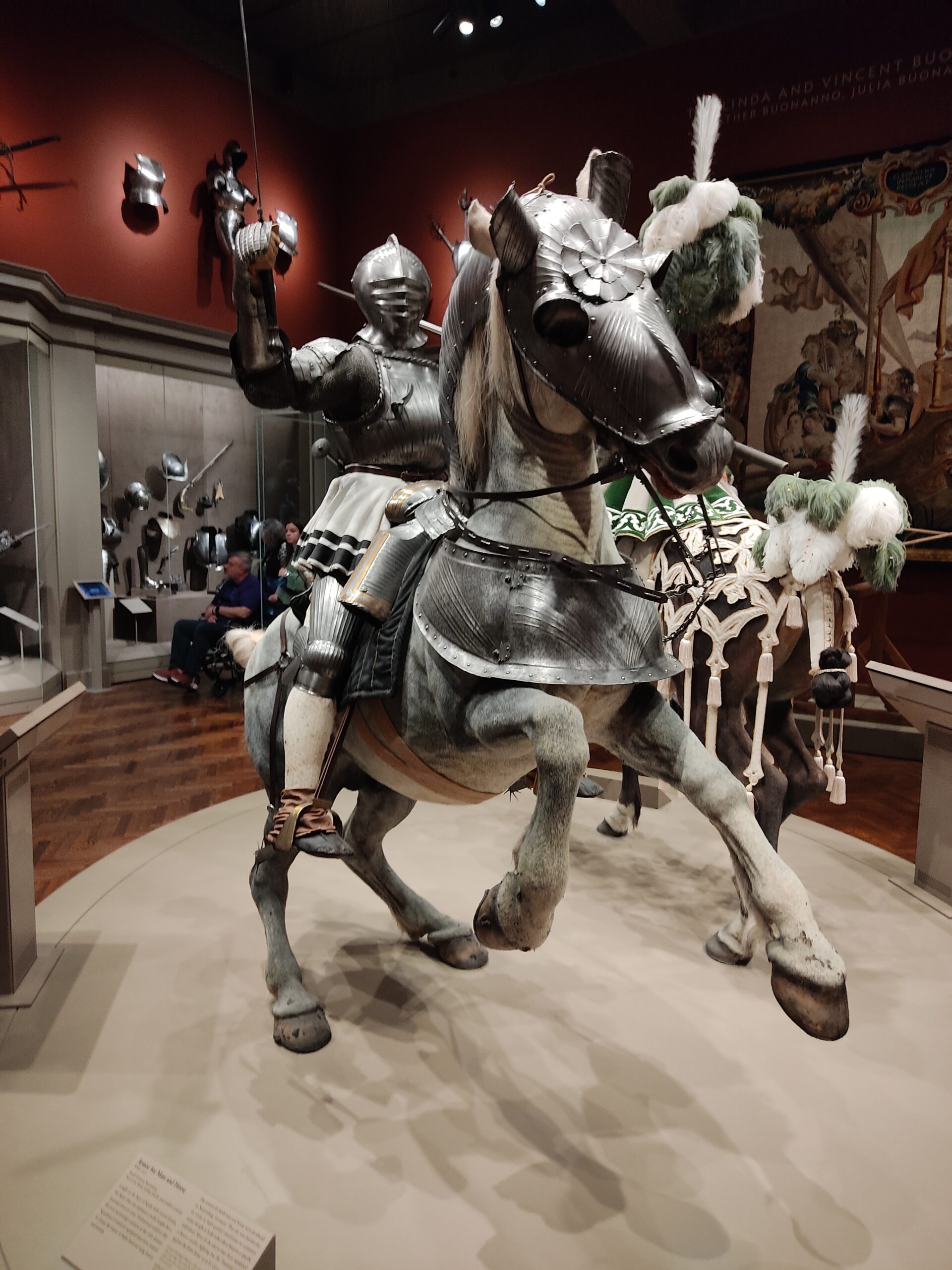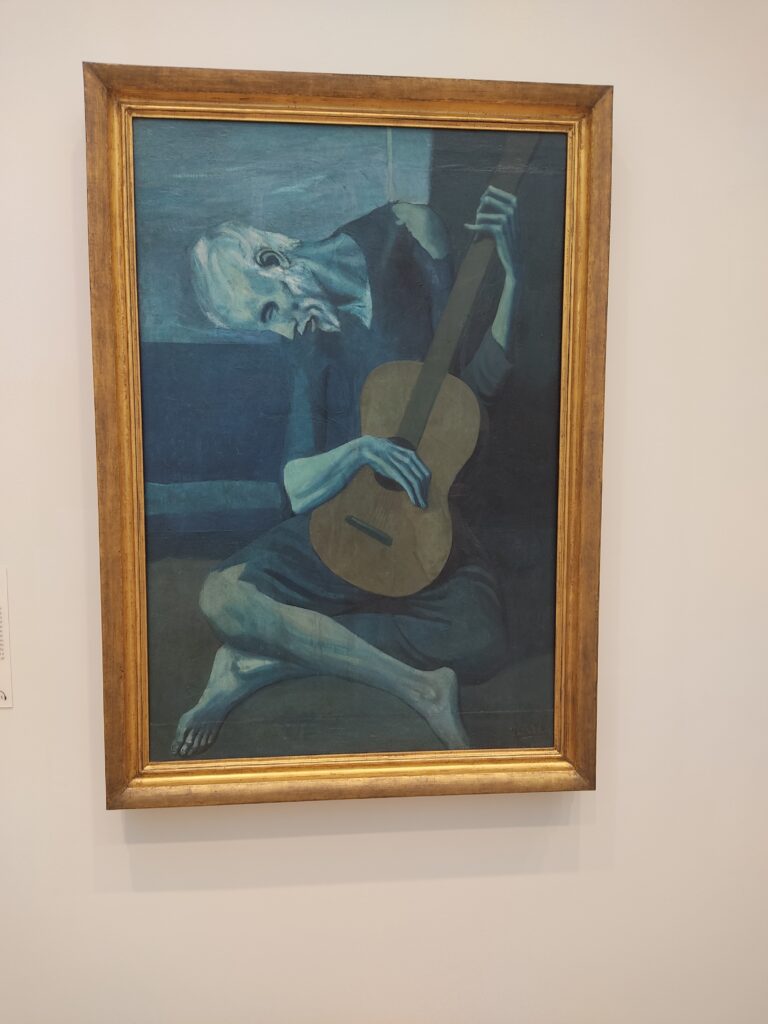Are you running short on time but don’t want to miss the most important places at the Chicago Art Institute? We’ve got an itinerary for you to see the main works of art in under an hour.
1. Hero Construction
Richard Hunt
Woman's Board Grand Staircase

Richard Hunt created Hero Construction in 1958, one year after graduating from the School of the Art Institute of Chicago. The sculpture is composed of found objects—old pipes, bits of metal, and automobile parts—that the artist discovered in junkyards and on the street. Using a torch like a paintbrush, Hunt welded these elements into a form that is abstract yet recognizable.
Hunt was fascinated with mythology, and Hero Construction can be related to other sculptures past and present, from ancient statues of Greek heroes to modern monuments of statesmen. The modest but monumental stance of the figure suggests a contemporary hero who maintains strength in the face of the uncertainties and dangers of the present age.
2. Hartwell Memorial Window
Tiffany Studios
Gallery 200, 2nd Level

More than 100 years ago, Agnes F. Northrop designed the monumental Hartwell Memorial Window for Tiffany Studios as a commission from Mary Hartwell in honor of her husband, Frederick Hartwell, for the Central Baptist Church of Providence, Rhode Island (now Community Church of Providence). Composed of 48 panels and numerous different glass types, the window is inspired by the view from Frederick Hartwell’s family home near Mt. Chocorua in New Hampshire. The majestic scene captures the transitory beauty of nature—the sun setting over a mountain, flowing water, and dappled light dancing through the trees—in an intricate arrangement of vibrantly colored glass.
3. Buddha Shakyamuni Seated in Meditation (Dhyanamudra)
Nagapattinam, Chola period
Gallery 140, 1st level

This 12th-century statue of the Buddha comes from the south Indian coastal town of Nagapattinam, where Buddhist monasteries flourished and attracted monks from distant lands. He is seated in a lotus posture of meditation, with hands and feet resting atop one another. The mark on his forehead is called the urna, which distinguishes the Buddha as a great being.
4. Face Mask (Ngady Mwaash)
Kuba
Gallery 137, 1st level

The densely painted and geometrically patterned Kuba mask is a ngady mwaash, an idealized representation of a woman that honors the role of women in Kuba life. Ngady mwaah most often appear as part of a trio of royal masks in reenactments of the Kuba Kingdom’s origins, which are staged at public ceremonies, initiations, and funerals. In these masquerades, the ngady mwaash dances together with the mooshamb-wooy mask, which represents the king (who is both her brother and her husband), and the bwoom mask. Male mask characters like bwoom display aggression and heaviness while female characters like ngady mwaash dance in a sensuous and graceful manner even though the mask is always worn by a man.
5. Field Armor for Man and Horse
South German, Nuremberg
Gallery 239, 2nd level

Caught in the heat of battle with sword raised and horse rearing, this mounted figure may match many notions of a knight in shining armor but actually represents a common hired soldier. The armors for both man and horse were produced in Nuremberg, Germany, in the 16th century, but the clothing was meticulously recreated in 2017 from period designs. Look for the special leggings: small plates of steel are sewn between two pieces of linen to protect the soldier’s legs. You’ll also spot some splashes of mud and grime from the battlefield.
6. A Sunday on La Grande Jatte
Georges Seurat
Gallery 240, 2nd level

For his largest and best-known painting, Georges Seurat depicted Parisians enjoying all sorts of leisurely activities—strolling, lounging, sailing, and fishing—in the park called La Grande Jatte in the River Seine. He used an innovative technique called Pointillism, inspired by optical and color theory, applying tiny dabs of different colored paint that viewers see as a single, and Seurat believed, more brilliant hue.
7. The Bedroom
Vincent van Gogh
Gallery 241, 2nd level

This sun-drenched composition with its vivid palette, dramatic perspective, and dynamic brushwork depicts Van Gogh’s bedroom in his house in Arles, France, his first true home of his own. Van Gogh dubbed it the “Studio of the South” in the hope that friends and artists would join him there. He immediately set to work on the house and painted this bedroom scene as a part of his decorating scheme. Van Gogh liked this image so much that he painted three distinct versions—the other two are held in the collections of the Van Gogh Museum in Amsterdam and the Musée d’Orsay in Paris.
8. Sky above Clouds IV
Georgia O’Keeffe
Gallery 249, 2nd level

9. Nighthawks
Edward Hopper
Gallery 262, 2nd level

This iconic painting of an all-night diner in which three customers sit together and yet seem totally isolated from one another has become one of the best-known images of 20th-century art. Hopper said of the enigmatic work, “Unconsciously, probably, I was painting the loneliness of a large city.”
10. The Wedding
Jacob Lawrence
Gallery 263, 2nd level

“I paint the things I have experienced,” Jacob Lawrence once said. In The Wedding, Lawrence depicted both the solemnity and the joy of a marriage ceremony and the coming together of families. Positioning the figures with their backs to the viewer, Lawrence’s composition invites us to participate in the couple’s major life event. Although the preacher’s face is only partially defined, he appears to look down with great seriousness as the two contemplate their vows. The large, colorful urns overflowing with flowers signify happiness and may also represent the future prosperity of this union.
Lawrence depicted the histories and events of black Americans—whether through individual compositions such as The Wedding that commemorated the everyday activities of his fellow Harlem residents, or through series of paintings that explored subjects ranging from the Great Migration to the story of Harriet Tubman.
11. The Old Guitarist
Pablo Picasso
Gallery 391, 3rd level

Pablo Picasso’s The Old Guitarist is a work from his Blue Period (1901–04). During this time the artist restricted himself to a cold, monochromatic blue palette and flattened forms, taking on the themes of misery and alienation inspired by such artists as Edvard Munch and Paul Gauguin. The elongated, angular figure also relates to Picasso’s interest in Spanish art and, in particular, the great 16th-century artist El Greco. The image reflects the 22-year-old Picasso’s personal sympathy for the plight of the downtrodden; he knew what it was like to be poor, having been nearly penniless during all of 1902.
12. Africa Restored (Cheryl as Cleopatra)
Kerry James Marshall
Gallery 295, 2rd level

Chicago-based artist Kerry James Marshall applies themes from art history to examine and recontextualize the representation of black culture. This work references nkisi nkondi, or power figures, of the Democratic Republic of Congo—sculptures into which metals, mirrors, and nails were driven to channel their forces. Marshall affixed his sculpture with “medallions” or “icons,” laminated images and texts that refer to figures within the black freedom movement in America as well as to Egyptian iconographies championed by African Americans in the 1970s as a way to challenge dominant Western worldviews. Marshall adds new elements each time the sculpture goes on view, treating it like a living and continually evolving work.
In case you want to learn more about the Chicago Art Institute or if you have any questions regarding any topic about the museum you can go to their official website. Click Here
